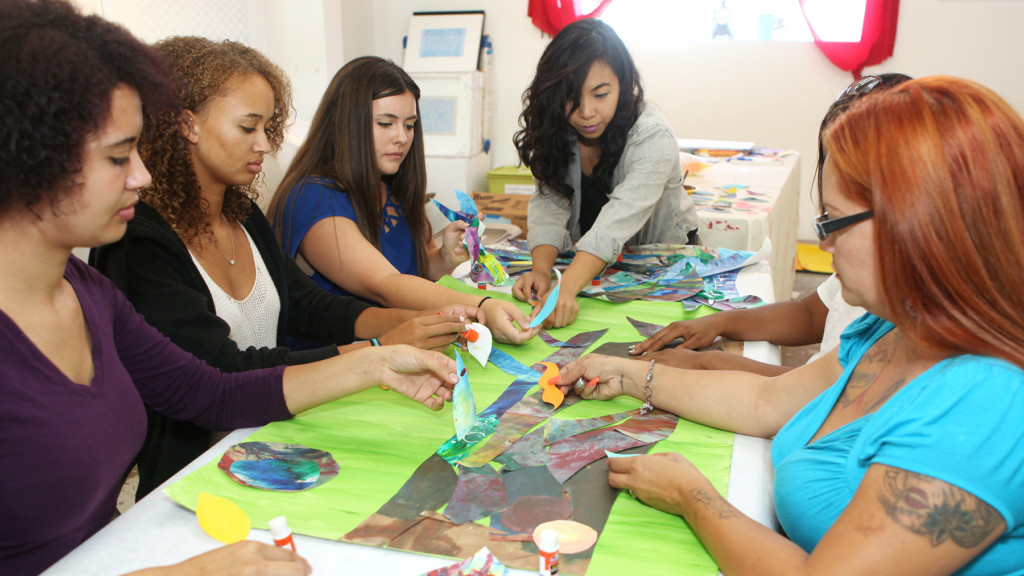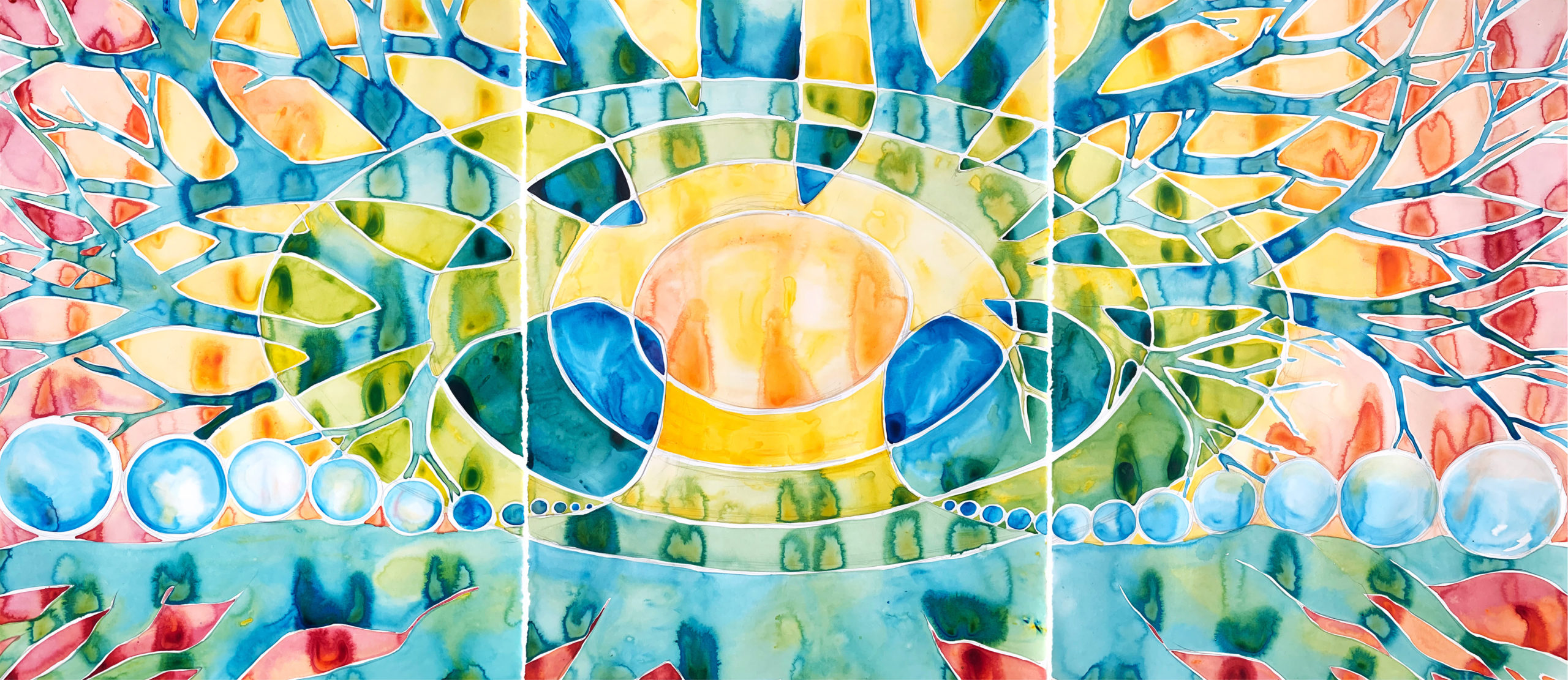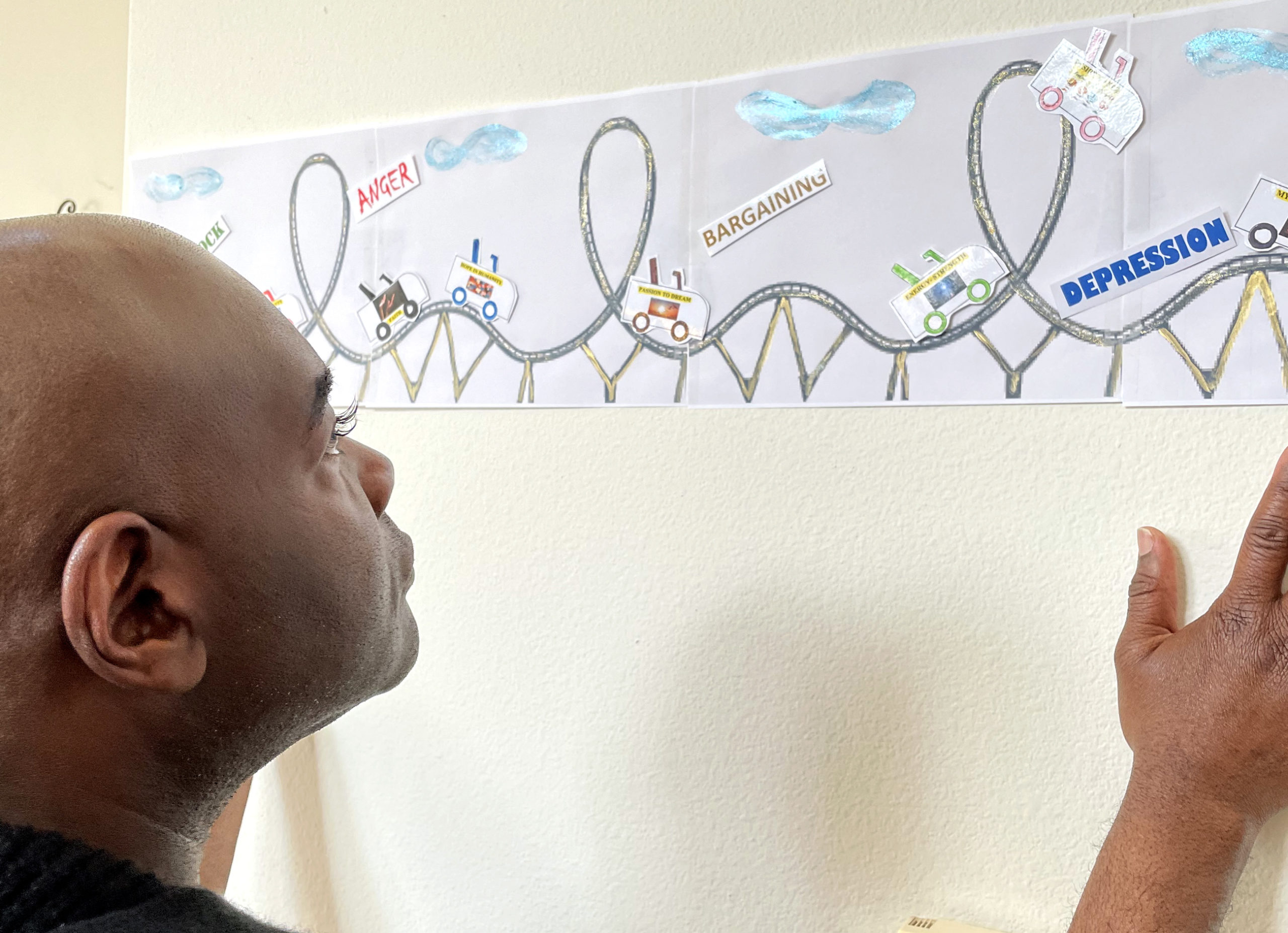May 25, 2020, would forever be the day that sparked radical personal growth within me. This was the day that a White Minneapolis, Minnesota police officer, named Derek Chauvin, knelt for 10 minutes on the neck of a Black man named George Floyd. This act would ultimately kill George Floyd and spark a major movement in America against historically longstanding and ongoing police brutality against Black people and other non-White people in America.
I invite you to use art to hold and honor your grieving and your healing, and hold all the moments in the journey.
This would be the day that ignited within me past feelings of shame, confusion, fear, celebration, and courage that have resided for over 50 years in my body, mind, soul, and spirit as a Black person. It would also be the day where I started grieving the undeniable fact that I had succumbed to the sad truth that I have been living in these “un” United States in America – truly unable to relax into citizenship as my other White counterparts have been privileged to do since the time they came out of their mother’s wombs.
For the racial distress of being a Black person in America automatically creates inherent, implicit, and explicit moments of racial distress on the hearts of those of us, with the happenstance to have been born of non-White families.
If the grieving process ultimately includes radical acceptance of what is; how do you radically accept that there are millions of people who want you dead because you’re Black…yet; be expected to continue functioning as a contributing, law abiding, peaceful, fun-loving human being?
Racial distress, racial trauma, or race-based traumatic stress (RBTS) refers to the mental and emotional injury caused by encounters with racial bias and ethnic discrimination, racism, and hate crimes. Our BIPOC communities tend to be the most affected and vulnerable as the States continue to be ruled by systems of White Supremacy. The effects of RBTS come because of ongoing physical assaults, insults, invalidations, and active systemic prejudicial acts of exclusion and inequities.
The most distressing piece of racial trauma is the constant practice of second guessing what is actually happening to you in real time (i.e. “maybe they pulled their purse up and held it tight as you were approaching because the strap was breaking” “maybe they really didn’t see you for 20 min and that’s why it took so long for them to finally address you and take your order”)
 Living over 50 years with these ongoing experiences, it makes sense why it’s so hard to fully relax; why it is sometimes physically painful to feel like you must smile all day just to “join the world.” Or more exhaustingly, feel like you must overperform, overwork, and positively overwhelm the crowd just so they don’t just see the dark Black complected person, but be able to penetrate through the color of my skin to connect with the human. IT IS EXHAUSTING!!!
Living over 50 years with these ongoing experiences, it makes sense why it’s so hard to fully relax; why it is sometimes physically painful to feel like you must smile all day just to “join the world.” Or more exhaustingly, feel like you must overperform, overwork, and positively overwhelm the crowd just so they don’t just see the dark Black complected person, but be able to penetrate through the color of my skin to connect with the human. IT IS EXHAUSTING!!!
As the events of George Floyd and the ever-increasing rise of the Black Lives Matter (BLM) movement have started to gain more and more attention and reactions throughout the last couple of years, so has the demand for mental health services. Consequently, there was also a dramatic increase in the demand for BIPOC mental health workers. This meant, that I, in my profession, had to continuously keep an open mind and an open heart for more than 30 clients a week while trying to find time to process my own thoughts, pain, hurt, and grief of what I was experiencing during these turbulent times as a dark-skinned, Black man trying to maneuver the plight of the ever-increased disunion of America. Doing the Riding the Grief Coaster AWBW art project, which ultimately became my outlet and outpouring of all the fragmented internal emotions that laid disturbed within my soul, was born out of racial fatigue and years of trauma (some of which had rested dormant for several years).
I would venture to say that this was the most elaborate AWBW project I ever created because I had become so numb, so emotionally sick, and tired; I was desperate and dedicated to dislodging myself from the grief and loss of my safety as a Black person that had so strongly taken root and nested within my heart.
 Each car labeled on the train represented the different parts of me adversely affected as I witnessed George’s death unfold in front of me, including Hope in Humanity, Sense of Safety, My ‘Love-Light’, My Faith and My Creativity. These are some of the areas I recognized were damaged as a result of years of struggling with race-based traumatic stress.
Each car labeled on the train represented the different parts of me adversely affected as I witnessed George’s death unfold in front of me, including Hope in Humanity, Sense of Safety, My ‘Love-Light’, My Faith and My Creativity. These are some of the areas I recognized were damaged as a result of years of struggling with race-based traumatic stress.
I created my grief roller coaster track in such a way that I could take things off. I can take them and move them anywhere on the track that I need to. I go in at least once a week and look at my roller coaster and I try to see where I’m at at any given time. I think this is probably going to be part of my healing for a really, really long time.
If there was any positively powerful result of what has occurred through the pain of the killing of George Floyd, and the seemingly permissible acts of White people feeling more empowered to discriminate and disenfranchise Black people and other non-White humans over the last 2 years, it is the unprecedented outcry for support from advocates within the mental health community.
When I have the privilege of supporting someone through the process of grieving their loss of safety because of the color of their skin or other universally marginalized personal characteristics, there are a few suggestions that I usually offer. I invite you to partake of these ideas as you continue to expand in your own journey of healing:
- FIND YOUR SAFE SPACE COMMUNITY! – Instead of wallowing over those who do not honor your entirety, allow yourself to be bathed in the respect and kindness of those who build you up, honor your wholeness, encourage your talents, and do not expect you to be anything but the true, authentic you!
- MIND YOUR BANDWIDTH – In the midst of a racially charged traumatic event, you may find yourself unable to take an action at that time. In the aftermath, you may still feel resigned to figure out how to manage the experience. Know and believe that pausing is okay and thwart off any thoughts of shame or guilt for not acting in the moment. Avoid “should have” statements as dealing with racial distress is an exhausting and not always easy task. If your bandwidth at the time demands that you take time to reflect, respect that feeling. If you choose to react/respond or not; give yourself grace, not more hate.
- SUPPORT AN AFFIRMING COMMUNITY – If you have the time, resources, and bandwidth to do so, supporting a local business, mentoring someone of a disenfranchised group and a host of other opportunities may exist to help address your own experiences with racial distress and trauma as well as create a chance to support a fellow like-minded being.
- LIMIT SOCIAL MEDIA USE – It is already a daunting task to be a member of a disenfranchised community and deal with racial distress on an ongoing basis. The one thing we do have control over is the amount of media coverage we expose ourselves to. It is perfectly okay to take a break from the constant barrage of information we are hit with via the news, gossip, and other forms of media. Although it is important to stay informed; it is more important to have awareness and tracking of how much information is overloading your senses and creating mental, physical and emotional fatigue. Studies have concluded that taking sabbaticals from social media can have positive effects on the psyche, self-esteem and help promote needed moments of mindful relaxation.
- CELEBRATE SELF & SELF CARE – Any small act of self-love (e.g. getting out of bed even when the world is scary and unpredictable, standing in that place even if you are the only person of color in the room, or the only LGBTQ+ person it that room, whether you are the only person without a degree of higher education in that room, whatever small victories you achieve, and when someone acknowledges and compliments your achievements, you CLAIM THEM!! Additionally, as hard as it may be, try to muster up some motivation to continue to do the things that make YOU happy, place you in a peaceful state and bring you joy (i.e., spending quality time with your family and friends, taking your dog on walks, sitting idly by the pool or watching waves come in, watching your favorite television show, crafting, cooking, shopping, exercising, etc.) These are part of the “building blocks” that continuously create the resiliency needed to be able to continue striving though the world we live in.
As you journey, I invite you to use art to hold and honor your grieving and your healing, and hold all the moments in the journey. For me, this is what I needed to see to start to heal. I was alive again.
Christopher Harriott, MA, MS, LMFT
Windows Facilitator
Ventura, California
Want to learn more about Christopher riding the grief roller coaster?
View Video
Want to utilize art to help people navigate through trauma including race based traumatic stress?
Attend a Training
A Window Between Worlds (AWBW) supports hundreds of direct service organizations across the country to incorporate creative expression into their work with trauma survivors. With this blog we uplift the voices of our art workshop facilitators and participants. We invite you to take in this perspective, notice what resonates and explore how it may fit into your life.





